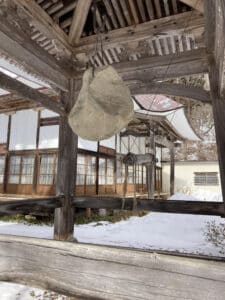The Sound of the Stone Bell
Jeffrey Mensendiek serves with J.F. Oberlin University in Tokyo, Japan.

This is a story I recently heard from a Buddhist priest named Odake (pronounced Oh Dah Kay). Back when Japan was in the midst of its imperial-colonial war (known either as the Second World War or the Fifteen Year War), the Japanese military needed any and all available metal objects in order to produce bullets and weaponry. That meant household goods like knives, pots and pans as well as farm tools such as sickles and plows were confiscated by the government. For Buddhist temples this meant the confiscation of their beloved temple bell. Odake is the seventeenth generation to serve as priest in his small temple in Hiroshima. Their bell was also confiscated during the tenure of his grandfather, but now they are fortunate to have a beautiful bell that brings much joy to the people in Odake’s village.
Odake recently learned of a temple tucked away in the mountains of Nagano Prefecture called Shomyoji. He happened on a book called “The Story of the Stone Bell” written by a woman named Inako. The temple bell in Inako’s village was confiscated during the war just as all temple bells were, but the villagers in Inako’s village decided to hang a large stone bell in its stead. The priest at Shomyoji had gone off to serve in the war so Inako’s family was responsible for taking care of the temple. Even after the war ended, times were hard and food was scarce. The government called on all Japanese citizens to make good use of the land to produce food for the population. This meant that many trees were forcibly taken down to make room for agricultural land. One day authorities showed up at Inako’s temple intending to cut down the two-century-old cherry tree (sakura) that stood beside the structure which held the stone bell. Inako was only thirteen at the time. She tells of how she succeeded in saving the sakura tree, and in the process tells the story of the villagers deciding to hang a stone bell at Shomyoji as a silent reminder of all the lives lost to the tragedy of war.
Odake decided to visit Inako’s village to see the stone bell for himself. It felt like a pilgrimage of sorts to travel to a forgotten village deep in the mountains. By now Inako was in her eighties. She was happy to receive Odake and to share her story. She told him that after the book was published many people came from all over the country to see the stone bell. She told of how they would pause in front of the bell in prayer to show their respect for the deceased; the young and unfulfilled lives that had been lost to war so many years ago. Inako shared how happy she was to see each visitor carry the story of the stone bell back with them. It felt as if she could hear the stone bell reverberating around the world; a silent reverberation calling for peace out of a deep respect for the unfulfilled young souls lost at war. The bell rings in every heart that refuses to let the memory of the dead be lost in vain.
Two international interreligious peace conferences coincided in Japan this February. One held in Okinawa was “The 8th Global Interreligious Conference on Article Nine” sponsored by the National Christian Council in Japan. The conference slogan was “Article Nine of the Japanese Peace Constitution and Peace in Asia – Prayer from Okinawa.” It brought together nearly one hundred people from Japan, Korea, Taiwan, the Philippines and the U.S. to share information about the military buildup in the region. Participating ecumenical bodies also reaffirmed their commitment to preserving Article Nine of the Japanese constitution which prohibits the government from waging war. Article Nine stands as a living reminder to the whole world that where there is a will to make peace, there are ways to hold our political leaders back from embarking down the dark path of war. I was serving as simultaneous translator at this conference, and that is where I met Rev. Odake and heard the story of the stone bell. The other conference, “The 2nd Tokyo Peace Round Table” gathered under the slogan “Beyond War, Toward Reconciliation.” It was sponsored by the World Religions for Peace (WCRP) an organization representing a Buddhist sect called the Risho Koseikai which I have grown to respect in recent years. They brought together religious leaders from 16 different countries, including churches in Russia and Ukraine, each of whom had been officially recognized from their respective religious bodies to attend the conference. There were also leaders from religious institutions in Israel and Palestine, Myanmar, Columbia, Mali and Haiti. In their conference statement WCRP stated that religious leaders have the responsibility to build bridges of communication and trust between countries and peoples. Participants had the opportunity to visit various Japanese cultural and religious sites. Sharing these experiences helps to build trust even when there are no immediate answers to the ongoing situations of conflict around the world.
I close with a prayer. May we journey together to find the stone bells in our lives. May the sound of the stone bell reverberate in our hearts.
Jeffrey Mensendiek serves with J.F. Oberlin University in Tokyo, Japan. His appointment is made possible by your gifts to Disciples Mission Fund, Our Church’s Wider Mission, and your special gifts.
